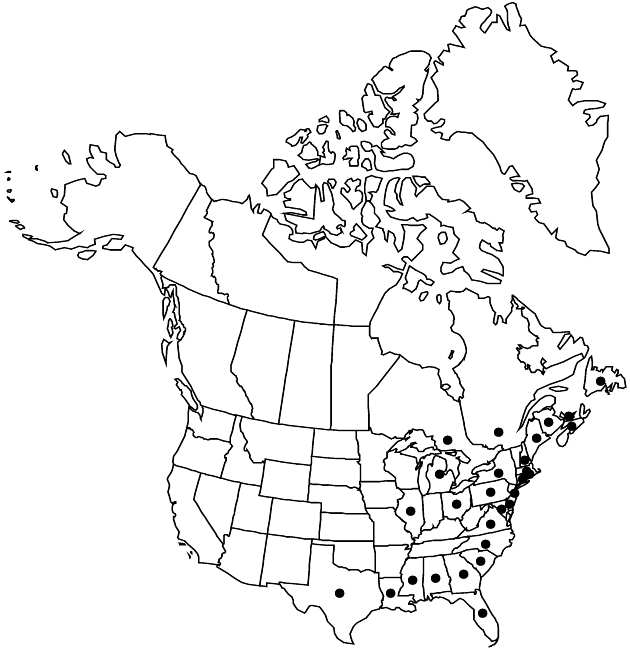Solidago sempervirens
Sp. Pl. 2: 878. 1753.
Plants 40–200 cm; caudices short, stout. Stems 1–10 (–20+), erect or ascending, glabrous throughout or hairy in arrays. Leaves: rosettes present at flowering; basal and proximal cauline tapering to long, winged petioles sheathing stems or nearly so, blades narrowly ovate to oblanceolate, 100–400 × 10–60 mm, thick or fleshy, entire, acute, glabrous; mid to distal cauline usually numerous, sessile, blades lanceolate, 40–60 × 5–10 mm, reduced distally, thick or fleshy, bases sometimes subclasping, margins entire. Heads 20–500, secund, in paniculiform arrays, secund-pyramidal to broadly club-shaped, sometimes leafy proximally, at least proximal branches spreading-recurved, branches and peduncles bracteolate, bracteoles reduced distally. Peduncles 2–3 mm, glabrous or sparsely hairy. Involucres 3–7 mm. Phyllaries in 3–4 series, unequal, lanceolate, margins ciliate, apices acute. Ray-florets 8–17; laminae 5–6.2 × 0.4–0.6 mm. Disc-florets 10–22; corollas 3–3.2 mm, lobes 0.5–1.2 mm. Cypselae (obconic) 1.1–1.5 mm, moderately strigose; pappi 3.8–4 mm (slightly clavate).
Distribution

N.B., N.S., Nfld. and Labr. (Nfld.), Ont., P.E.I., Que., Ala., Conn., Del., Fla., Ga., Ill., La., Maine, Mass., Md., Mich., Miss., N.C., N.H., N.J., N.Y., Ohio, Pa., R.I., S.C., Tex., Va., Mexico, West Indies, Central America, inland around Great Lakes, to Atlantic Islands (Azores)
Discussion
Subspecies 2 (2 in the flora).
Solidago sempervirens is common along the seacoast from the Gulf of St. Lawrence to central America and the northern West Indies. Introduced populations are sometimes very large near the Detroit River and Lake Erie in southwestern Ontario, eastern Michigan, and adjacent Ohio. A second disjunct group of populations occurs in Illinois and Indiana in the Chicago area at the southern end of Lake Michigan. Two mostly geographically separate subspecies can be recognized in the flora range. A race also occurs in the Azores and is undoubtedly introduced there [Solidago sempervirens var. azorica (Hochstetter ex Seubert) H. St. John]. Plants cultivated in European gardens have been labeled S. sempervirens var. viminea (Aiton) A. Gray.
Selected References
None.
Key
| 1 | Involucres 4–7 mm, rays 12–17, disc florets ca. 17–22; Newfoundland to New Jersey, locally to Virginia | Solidago sempervirens subsp. sempervirens |
| 1 | Involucres 3–4 mm, rays 7–11, disc florets ca. 10–16; Massachusetts to Texas and southward | Solidago sempervirens subsp. mexicana |
No values specified.